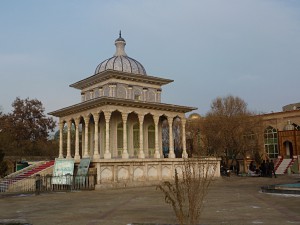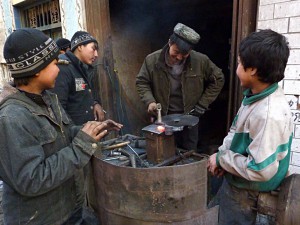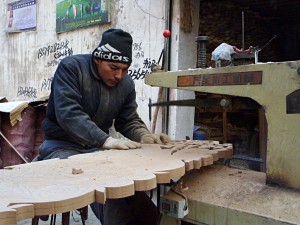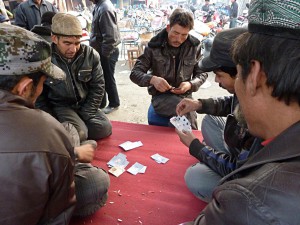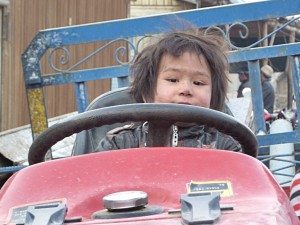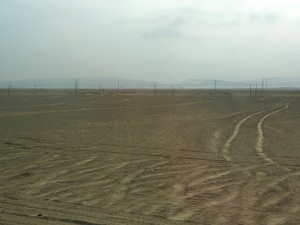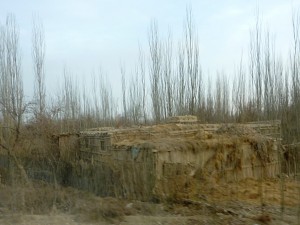After the visit of Kashgar I intended to travel along the Southern route of the silk road around the Takla Makan desert to visit another Sunday Market, this time on a Sunday. I decided to stop in the city of Yarkand (Shache), which apparently had to offer an impressive market.
I was up early when I left the Youth Hostel in Kashgar for Yarkan. According to the guide book there should be bus running between the two cities every half an hour, but only one train during the day at 10:46am Beijing time. There were two reasons why my plan did not work as intended: first of all there was an atmosphere which reminded of Christmas, the city was lit be the street lights and large snow flakes were falling from the sky. The second reason was the fact that I only got a ticket for a bus leaving Kashgar at 11am Beijing time, which meant later than the train. Due to the snow and the resulting conditions on the road the bus ride did not take the indicated four hours, but five and a half.
After my arrival in Yarkand I first wanted to find a place to sleep before I started looking for the market. I took a look into two hotels only to find out that their room rates were much more than I intended to pay. When I wanted to leave the second hotel, the receptionist stopped me to let me know that the indicated prices were not relevant and that the actual price was about half of that. Once I had seen the room I decided that the price was fair and thus took the room. Theoretically there even was an Internet connection in the hotel, but the helpful receptionist had no idea how I had to setup my netbook to make it work. Finally he showed me two icons on the desktop of the computer at the reception, which were labeled VPN and gave me a phone number and a password. I still have no idea what I was supposed to do, but I assume that the access information he gave me were actually for the one open WLAN which required a phone number and a password, but too bad I couldn’t really try out, because I was unable to decipher the password he had written down.
I didn’t spend too much time with the Internet connection, since I was in Yarkand to visit the Sunday Market and not to surf the Web. The sights and the market were also going to be much nicer during daylight of which there was not much left. So I headed out the hotel and followed the main road to find the mosque and the mausoleums around it. As always when I want to visit a mosque it was prayer time and thus I could not disturb the people inside the mosque. However when I discovered it was praying time I already stood inside the courtyard of the mosque. This gave me the possibility to briefly take in the view of the historical building. Directly in front of the mosque is the shrine of Ammanisahan. Besides the mosque there is a small cemetery with further mausoleums at which I took a look over the wall surrounding it.
Wherever there is a mosque, the bazaar cannot be far. I had to recall this fact when I headed the wrong way from the mosque to look for the market. Once back at the mosque I found a small side road where people were hammering on melted metal. This was the first side street of the market, which I then found out filled a whole part of the city. Contrary to other cities where the market is contained in a bazaar or in other kinds of buildings, the one of Yarkand takes only place in the streets. The streets were quite dusty and the focus clearly lay on agricultural products and handicrafts.
The street with the metal workers offered multiple possibilities to by car axles and other spare parts. As in Kashgar the people were hammering away at their metal pieces and bending metal parts. When I saw one fellow sawing a piece of wood I felt like in my childhood. Just the tools he used were more sofisticated than what we had when we were little. As with anybody who was actively working on something, there were curious people watching the man cutting the would. I thus joined them for a couple of minutes.
Not very far into the market I again found the food stalls where one could find more than just the regular kebabs. Heads and feet of lamb was being boiled and grilled and other small parts of the animals was offered in different pots. I admit I did not feel like trying all that food and rather stuck to the things I am at least partly familiar with… Yarkand was the first place where the barbeques were not run with coal but rather with regular wood. To achieve a long lasting fire, a funnel was attached to the end of the barbeque, where the wood was burned. The hot ashes the fell through an opening into the barbeque. A clever and practical solution.
In one of the side streets I suddenly saw a small square packed with motorcycles. The motorcycles already provided excelent material for a picture, but even more interesting was what was going on behind the parked vehicles. Underneath plastic covers there were many tables, chairs and pool tables. As in Malatya in Turkey in the teahouse there were only men here playing their kind of pool and cards for money.
Once it started to get dark I headed back to my hotel with an intermediate stop for delicious Laghman for dinner. In the hotel I started my netbook to write about my experiences in Kashgar and sorted out the pictures of the past few days.
On Monday morning I went out for a small shopping tour to buy some food for the bus ride to Hotan. According to the guide book, the ride was going to take about six hours with the bus leaving at 12am Beijing time, which made it 10am Xinjiang time. That early in the morning it was not easy to find open stores are even stands on the streets which offered bread, mandarines and water.
Finally i had everything I wanted, went back to the hotel to pick up my backpack and headed to the bus station. Since I already had my ticket I could immediately proceed to the bus. The lady at the security gate didn’t even want to see my ticket nor did whe want to use the x-ray machine to scan my backpack. Once inside the bus station I was impressed how helpful all the people were who saw me standing there with only confusion in my face to which was going to be my bus. I finally ended up in the right bus.
Ahead of time we left the bus station to first slowly driver through the streets of the city to find as many more passengers as possible. Once again I started to have a feeling that the planned six hours would not be sufficient to make it to Hotan. The ride first led us through intensively used farmland to Yecheng, the turn-off to Tibet. About 15 minutes after Yecheng there was a sudden change in landscape. The conductor had to complete the formalities at the police check point and after taking off again everything around us disappeared. There were no more trees, no more buildings, it was all sand and rocks. We had entered the Takla Makan desert and drove at a quite impressive speed through the desert until about 20 kilometers before Hotan. During the drive we crossed a few oasis towns whenever we crossed a river and a forgotten bazaar in the middle of the desert and something that seemed like a labor camp where people were drying fruits and nuts. After exactly six hours we reached the bus station of Hotan.


